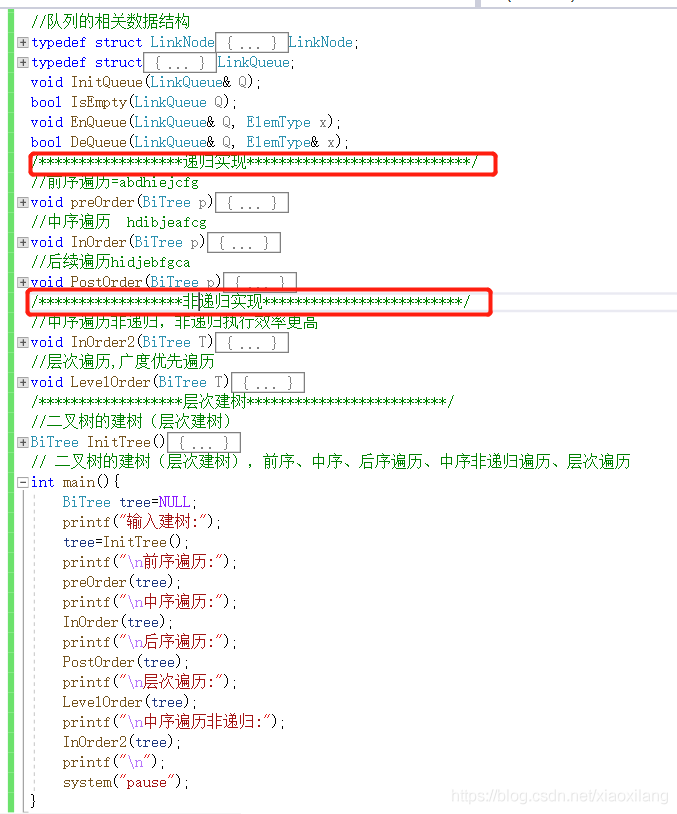二叉树和二叉排序树的操作
二叉树和二叉排序树的操作
参考书籍-王道-书籍结构-代码已在vs2019验证过!
1.二叉树的遍历
二叉树的建树(层次建树),前序、中序、后序遍历、中序非递归遍历、层次遍历
#include
typedef char BiElemType;
typedef struct BiTNode {
BiElemType c;//c就是书籍上的data
struct BiTNode* lchild;
struct BiTNode* rchild;
}BiTNode, * BiTree;
typedef struct tag {
BiTree p;
struct tag* pnext;
}tag_t, * ptag_t;
//栈的相关数据结构
#define MaxSize 50
typedef BiTree ElemType;
typedef struct {
ElemType data[MaxSize];
int top;
}SqStack;
void InitStack(SqStack& S);
bool StackEmpty(SqStack& S);
bool Push(SqStack& S, ElemType x);
bool Pop(SqStack& S, ElemType& x);
bool GetTop(SqStack& S, ElemType& x);
//队列的相关数据结构
typedef struct LinkNode {
ElemType data;
struct LinkNode* next;
}LinkNode;
typedef struct {
LinkNode* front, * rear;
}LinkQueue;
void InitQueue(LinkQueue& Q);
bool IsEmpty(LinkQueue Q);
void EnQueue(LinkQueue& Q, ElemType x);
bool DeQueue(LinkQueue& Q, ElemType& x);
/******************递归实现****************************/
//前序遍历=abdhiejcfg
void preOrder(BiTree p)
{
if (p != NULL)
{
putchar(p->c);//等价于visit函数
preOrder(p->lchild);
preOrder(p->rchild);
}
}
//中序遍历 hdibjeafcg
void InOrder(BiTree p)
{
if (p != NULL)
{
InOrder(p->lchild);
putchar(p->c);
InOrder(p->rchild);
}
}
//后续遍历hidjebfgca
void PostOrder(BiTree p)
{
if (p != NULL)
{
PostOrder(p->lchild);
PostOrder(p->rchild);
putchar(p->c);
}
}
/******************非递归实现*************************/
//中序遍历非递归,非递归执行效率更高
void InOrder2(BiTree T)
{
SqStack S;
InitStack(S); BiTree p = T;
while (p || !StackEmpty(S))//逻辑或||
{
if (p)
{
Push(S, p);
p = p->lchild;
}
else {
Pop(S, p); putchar(p->c);
p = p->rchild;
}
}
}
//层次遍历,广度优先遍历
void LevelOrder(BiTree T)
{
LinkQueue Q;
InitQueue(Q);
BiTree p;
EnQueue(Q, T);//树根入队
while (!IsEmpty(Q))
{
DeQueue(Q, p);
putchar(p->c);
if (p->lchild != NULL)
EnQueue(Q, p->lchild);
if (p->rchild != NULL)
EnQueue(Q, p->rchild);
}
}
/******************层次建树*************************/
//二叉树的建树(层次建树)
BiTree InitTree()
{
BiTree pnew;
int i, j, pos;
char c;
BiTree tree = NULL;//树根
ptag_t phead = NULL, ptail = NULL, listpnew, pcur=NULL;
//abcdefghij
while (scanf_s("%c", &c) != EOF)
{
if (c == '\n')
{
break;
}
pnew = (BiTree)calloc(1, sizeof(BiTNode));//calloc申请空间并对空间进行初始化,赋值为0
pnew->c = c;
listpnew = (ptag_t)calloc(1, sizeof(tag_t));
listpnew->p = pnew;
if (NULL == tree)
{
tree = pnew;//树的根
phead = listpnew;//链表头
ptail = listpnew;//链表尾
pcur = listpnew;
continue;
}
else {
ptail->pnext = listpnew;//新结点放入链表,通过尾插法
ptail = listpnew;
}
if (NULL == pcur->p->lchild)
{
pcur->p->lchild = pnew;
}
else if (NULL == pcur->p->rchild)
{
pcur->p->rchild = pnew;
pcur = pcur->pnext;
}
}
return tree;
}
// 二叉树的建树(层次建树),前序、中序、后序遍历、中序非递归遍历、层次遍历
int main(){
BiTree tree=NULL;
printf("输入建树:");
tree=InitTree();
printf("\n前序遍历:");
preOrder(tree);
printf("\n中序遍历:");
InOrder(tree);
printf("\n后序遍历:");
PostOrder(tree);
printf("\n层次遍历:");
LevelOrder(tree);
printf("\n中序遍历非递归:");
InOrder2(tree);
printf("\n");
system("pause");
} 2.二叉排序树
二叉排序树的遍历和搜索
#include
#include
typedef int KeyType;
typedef struct BSTNode {
KeyType key;
struct BSTNode* lchild, * rchild;
}BSTNode, * BiTree;
int BST_Insert(BiTree& T, KeyType k)
{
if (NULL == T)
{
T = (BiTree)malloc(sizeof(BSTNode));
T->key = k;
T->lchild = T->rchild = NULL;
return 1;
}
else if (k == T->key)
return 0;
else if (k < T->key)
return BST_Insert(T->lchild, k);
else
return BST_Insert(T->rchild, k);
}
void Creat_BST(BiTree& T, KeyType str[], int n)
{
T = NULL;
int i = 0;
while (i < n)
{
BST_Insert(T, str[i]);
i++;
}
}
//递归算法简单,但执行效率较低,实现留给大家编写
BSTNode* BST_Search(BiTree T, KeyType key, BiTree& p)
{
p = NULL;
while (T != NULL && key != T->key)
{
p = T;
if (key < T->key) T = T->lchild;
else T = T->rchild;
}
return T;
}
//这个书上没有
void DeleteNode(BiTree& root, KeyType x) {
if (root == NULL) {
return;
}
if (root->key > x) {
DeleteNode(root->lchild, x);
}
else if (root->key < x) {
DeleteNode(root->rchild, x);
}
else { //查找到了删除节点
if (root->lchild == NULL) { //左子树为空
BiTree tempNode = root;
root = root->rchild;
free(tempNode);
}
else if (root->rchild == NULL) { //右子树为空
BiTree tempNode = root;
root = root->lchild;
free(tempNode);
}
else {//左右子树都不为空
//一般的删除策略是左子树的最大数据 或 右子树的最小数据 代替该节点(这里采用查找左子树最大数据来代替)
BiTree tempNode = root->lchild;
while (tempNode->rchild != NULL) {
tempNode = tempNode->rchild;
}
root->key = tempNode->key;
DeleteNode(root->lchild, tempNode->key);
}
}
}
void InOrder(BiTree T)
{
if (T != NULL)
{
InOrder(T->lchild);
printf("%3d", T->key);
InOrder(T->rchild);
}
}
int main()
{
BiTree T;
BiTree parent;
BiTree search;
KeyType str[] = { 54,20,66,41,28,79,58 };
printf("\n创建二叉排序树:");
Creat_BST(T, str, 7);
InOrder(T);
printf("\n");
search = BST_Search(T, 41, parent);
if (search)
{
printf("找到对应结点,值=%d\n", search->key);
}
else {
printf("未找到对应结点\n");
}
DeleteNode(T, 40);
InOrder(T);
printf("\n");
system("pause");
}



